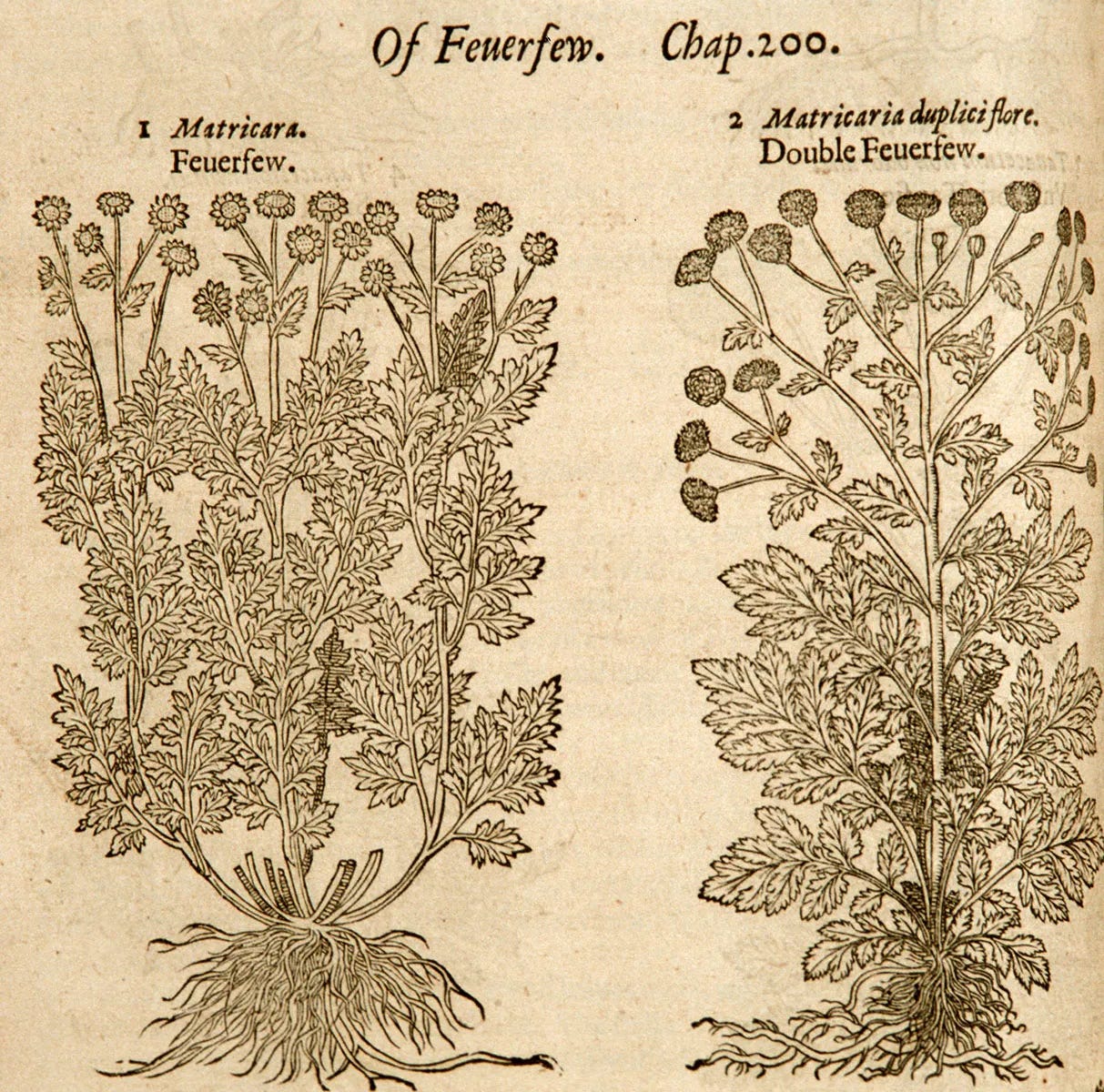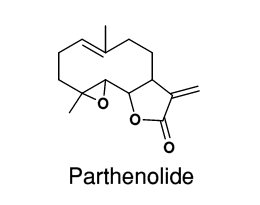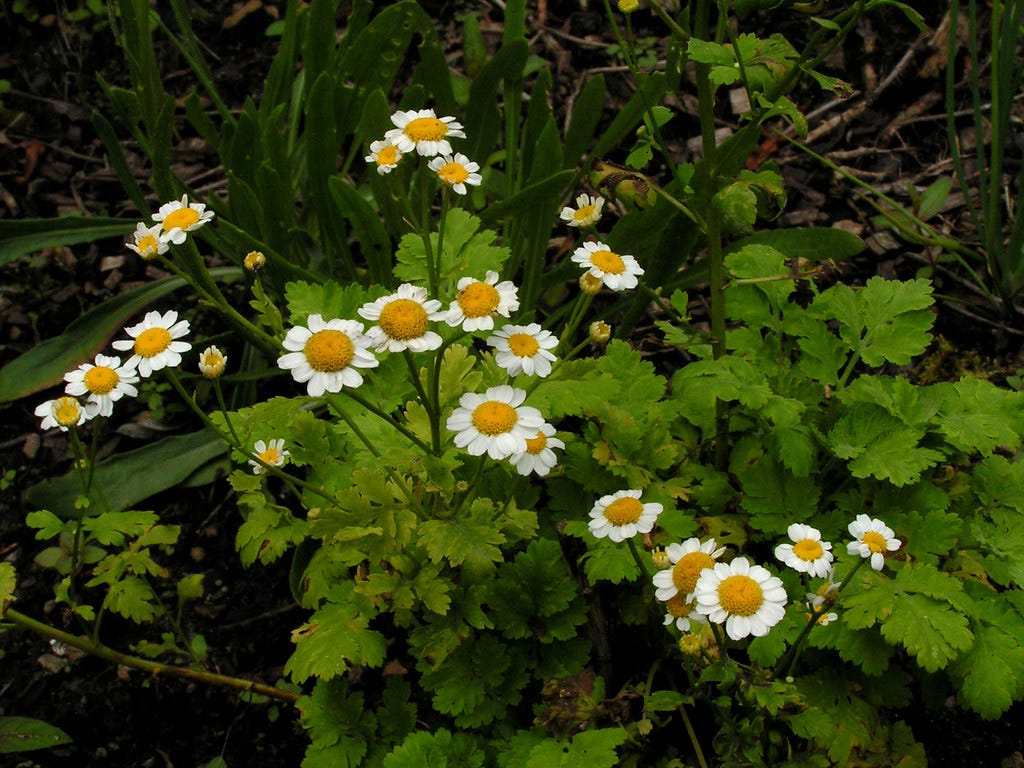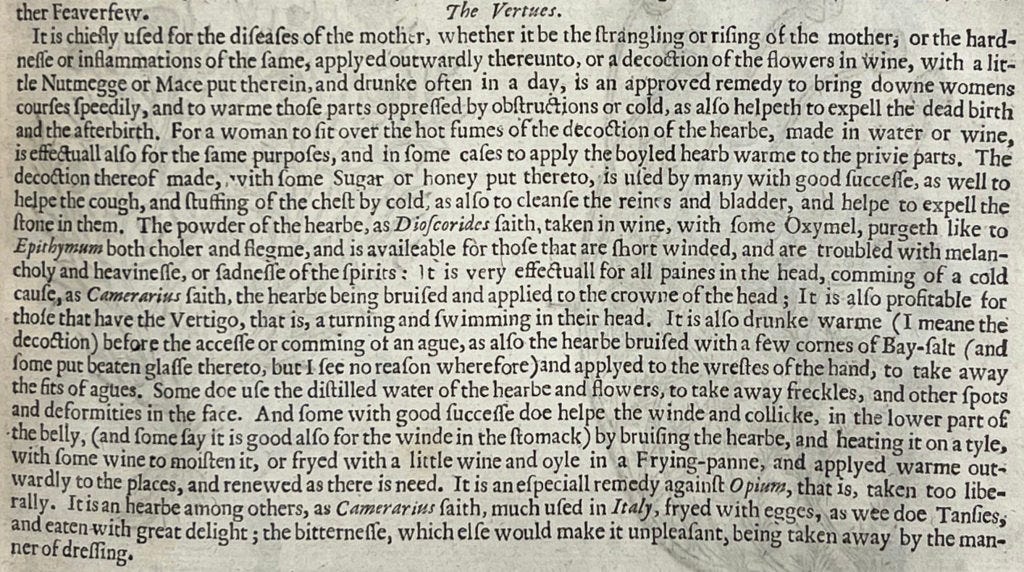Feverfew: A Bitter Bloom for Migraine, Inflammation, and the Art of Plant Precision
discover the history, healing properties, and lookalike warnings of Tanacetum parthenium—plus how to use this ancient herb safely, from materia medica to migraine tea.
When you begin studying herbalism, no one quite prepares you for just how many plants belong to the Aster family, or how bewilderingly alike they can seem at first glance.
Their sunny little faces, daisy-like blooms with cheerful petals, dot meadows, gardens, roadside ditches, and hayfields. To the untrained eye, they’re all cousins with no name tags.
I remember one of my earliest lessons in this, back when I was working at a horse farm. It was early summer. The pastures were full of tall grasses and weeds that brushed your boots and soaked your shins in morning dew. Scattered among them were delicate white flowers, small and golden-centered, with feathery leaves.
I was learning herbs in my free time and thought with excitement, Chamomile! Or maybe… feverfew? I crouched down, gently rolled a leaf between my fingers, and inhaled. It smelled herbaceous, almost fruity, like apples and earth. A barn hand passing by chuckled and said, “Oh, those? That’s pineapple weed.” And so it was: Matricaria discoidea, not chamomile, not feverfew, but something else entirely, with a sweet, calming scent and a name I hadn’t yet learned.
That moment has stayed with me ever since. It was the first time I realized that identifying a plant isn’t just about what it looks like. It’s about presence—texture, scent, season, where it’s growing, and the stories it carries.
Learning the difference between one daisy-faced bloom and another isn’t trivia. It’s the foundation of medicine making, plant connection, and safe practice.
So today, we’re exploring one of those easily confused but deeply powerful allies: feverfew (Tanacetum parthenium). It’s a plant of contradiction—gentle-looking, but pharmacologically fierce. A humble garden dweller with a resume that spans centuries of folk use and the latest in inflammation research.
Feverfew infloresence
If you’re a member of The Buffalo Herbalist Community, don’t forget to scroll to the end of this post for exclusive downloads, including a printable feverfew materia medica and a migraine-ease formula by Rosemary Gladstar, all in one place!
What Feverfew Really Is (and Isn’t)
Feverfew may look like a classic daisy at first glance, but it’s not your average garden variety. While its cheerful white petals and yellow center resemble a wild daisy or even a chamomile bloom, feverfew (Tanacetum parthenium) actually belongs to the chrysanthemum side of the Asteraceae family, sometimes referred to as the daisy chrysanthemum group.
It’s often mistaken for members of the Gerbera genus, but these plants come from entirely different origins. Gerbera daisies hail from South Africa, while feverfew traces its roots back to Asia and southeastern Europe.
Their leaves differ in shape and texture, and so do their growing preferences. Feverfew favors cooler, temperate climates and tends to appear in herbal gardens, roadsides, and field edges where the soil is dry and the sun is steady.
This is a perfect reminder of how botanical lookalikes can be deceiving—a point I learned the hard way in my early days, crouched in the pasture with pineapple weed in my hand and feverfew in my notebook.
A Glimpse into the History of Feverfew
Feverfew (Tanacetum parthenium), with its feathery leaves and daisy-like blooms, has a long-standing place in traditional medicine stretching back to the ancient world.
The Greeks turned to it for fevers and inflammation—its name even echoes that role. Dioscorides, the first-century physician and herbalist, specifically noted its cooling, antipyretic effects.
And centuries later, in medieval Europe, it was dubbed “medieval aspirin,” a go-to remedy for head pain and discomfort long before white pills filled medicine cabinets.
Its botanical name may hold an echo of legend. Some sources suggest the name parthenium stems from a story linked to the Parthenon itself, where a worker was reportedly healed after falling during its construction—revived, they say, with the help of this humble herb. Others trace the name to the Greek word parthenos, meaning "virgin," hinting at its historical use in gynecological complaints.
Across Central and South America, feverfew’s uses expanded beyond headaches and fevers. The Kallawaya people of the Andes regarded it as a remedy for everything from colic and kidney pain to morning sickness and digestive discomfort. In Venezuela, it’s still used traditionally for earaches.
Old text containing feverfew
Today, feverfew continues to bridge the worlds of folk tradition and clinical promise. Modern research identifies parthenolide—a sesquiterpene lactone—as its most pharmacologically active compound. Parthenolide is currently being explored for its anti-inflammatory, cardiotonic, and even anticancer properties.
While the science is still evolving, its wide range of actions makes feverfew one of those plants that reminds us how deeply rooted knowledge often aligns with emerging evidence.
Its essential oils have also found a place in the pharmaceutical and cosmetic worlds, thanks to their aromatic profile and therapeutic potential.
Whether it was crushed for fever, carried to soothe the womb, or steeped to calm the mind, feverfew’s journey through the ages tells a story of a plant with many lives—and many lessons still to offer.
From Palliative to Precise: Working with Feverfew Intentionally
Feverfew has long been revered for its role in easing migraine—a reputation it's reclaiming in both modern herbalism and conventional medicine.
While it’s often used as a general remedy for chronic migraines or inflammatory conditions like arthritis, its deeper power is revealed when prescribed with intention, guided by a person’s constitution, tissue state, and the energetic language of the body.
In non-specific use, feverfew is typically taken over time as a palliative, offering steady support rather than quick relief. This approach was formalized through the clinical work of Dr. Stewart Johnson in the 1980s, helping to re-establish feverfew’s credibility in both clinical and research settings.
But when used with a nuanced understanding of its energetics, feverfew emerges as a precise and elegant remedy for heat, stagnation, and overactivity—particularly in the vascular and nervous systems.
Herbalist Matthew Wood points to feverfew’s affinity for conditions marked by congestion and excess heat. It’s particularly helpful in migraines that feel hot to the touch at the temples and are soothed by warmth. It can be supportive in cases of varicose veins, arthritic flare-ups in their inflammatory stage, or menstrual discomfort characterized by painful cramping and delayed or sluggish flow.
For those navigating the transitions of menopause, feverfew may help relieve symptoms linked to blood stagnation or heat, such as hot flashes or pressure in the head.
It’s also been used in complex patterns involving dizziness or tinnitus—especially when paired with other herbs—and may offer support for hypertension when tension, inflammation, or emotional excess are involved.
Topically, it’s been used to ease bug bites and minor irritations with a strong inflammatory component.
Notably, feverfew is one of the only herbs in European phytotherapy recognized as a specific treatment for migraines, and it's among the few plants to earn acknowledgment from both traditional herbalists and modern physicians. Its actions are deeply rooted in its chemistry.
Parthenolide, its most active constituent, exerts anti-inflammatory and vascular effects by modulating arachidonic acid metabolism, inhibiting histamine secretion, reducing platelet aggregation, calming smooth muscle contractions in blood vessels, and exerting mild cytotoxic effects where inflammation is excessive.
This layered pharmacology explains feverfew’s ability to not only prevent migraines but also address broader inflammatory and circulatory patterns—especially when there's a signature of heat, pressure, or congestion at play.
Feverfew inflorescences
Parthenolide: Feverfew’s Star Compound
Let’s talk about parthenolide—the standout chemical found in feverfew (Tanacetum parthenium), and the reason this plant is getting so much scientific attention beyond the herbal world.
Parthenolide is what’s known as a sesquiterpene lactone, a type of compound that’s especially good at dialing down inflammation. But parthenolide doesn’t stop there—it’s also shown potential in early studies for supporting the body in targeting abnormal cell growth, like what we see in certain cancers.
That combination of anti-inflammatory and anti-cancer activity is what makes researchers so excited about it.
Here’s what’s fascinating: parthenolide works on multiple levels in the body. It’s been shown to interfere with inflammatory signaling pathways, especially ones like NF-κB and STAT, which are kind of like the body’s alarm systems.
When these are overactive, it can lead to chronic inflammation, pain, and even contribute to how cancer develops or persists. Parthenolide helps turn the volume down on those signals.
It also nudges cells toward apoptosis, which is the body’s natural process for clearing out damaged or dangerous cells.
What’s really interesting is that it seems to do this selectively—encouraging unhealthy or cancerous cells to self-destruct while leaving healthy cells alone. That’s not something many compounds can do, especially not naturally derived ones.
And while all of this sounds complex (because it is!), the takeaway is simple: parthenolide helps the body regulate when and how to respond to inflammation, while also protecting healthy tissue.
Think of it as a compound that supports clarity and boundaries—encouraging overactive, inflamed, or misbehaving cells to calm down or move on, without harming what’s working well.
Scientists are also exploring how parthenolide may influence things like oxidative stress, cellular cleanup systems, and even how our DNA is expressed in inflammatory states—but those are still early-stage studies.
For now, what we know is promising, and it continues to affirm what herbalists have observed for centuries: feverfew is not just a plant for pain relief—it’s a complex botanical with much more to offer.
Chemical structure of Parthenolide
Feverfew and Inflammation: A Look Inside the Cells
A study using human monocytic cells (THP-1) explored how feverfew extract—rich in parthenolide—affects immune response at the genetic and cellular level. Researchers used advanced tools like gene expression microarrays, RT-PCR, and ELISA assays to understand its effects.
Key Findings:
Over 400 human genes were significantly altered after treatment with feverfew extract at a very low concentration (0.01% dry weight):
245 genes were upregulated, including HMOX1 (heme oxygenase, 17.7-fold), HSPA1A (heat shock protein, ~10-fold), and IL-8 (a pro-inflammatory chemokine, ~9-fold).
155 genes were downregulated, including CCL2 (a chemokine linked to inflammation), AQP1 (a water channel protein), and RGS16 (a regulator of G-protein signaling).
Biological processes impacted included:
Nucleic acid metabolism
Cellular metabolic regulation
Lipid and alcohol metabolism
Protein folding stress responses
Validation and Cytokine Response:
To confirm the gene-level results, researchers conducted RT-PCR on 10 key genes, with results that mirrored the microarray trends, strengthening the reliability of the data.
Then they tested whether feverfew could reduce inflammatory cytokine release:
TNF-α production, stimulated by LPS (a bacterial endotoxin), was reduced by 54% with feverfew treatment.
CCL2 (MCP-1), which was already downregulated at the gene level, was also strongly suppressed at the protein level. At higher doses of feverfew extract, CCL2 production was nearly eliminated.
Safety Note:
Endotoxin contamination was ruled out, ensuring results reflected the herb, not bacterial interference.
Feverfew at low doses (≤0.01%) was non-toxic to cells, but higher concentrations (>0.04%) did decrease cell viability after 24 hours.
Takeaway
This study offers a rare molecular window into how feverfew modulates inflammation—not just through symptom relief, but by altering genetic expression related to immune response, stress adaptation, and cytokine production.
It supports feverfew’s traditional use for inflammatory conditions like migraines, arthritis, and systemic tension, while hinting at future applications in immune modulation.
Feverfew Safety: What You Should Know
Like many herbs with a strong personality, feverfew deserves both respect and understanding. It’s generally well tolerated for most people and has a long history of traditional use—but there are a few safety notes worth knowing before you start working with it.
First things first: feverfew is not recommended during pregnancy or breastfeeding.
It’s classified as a Safety Class 2b herb, meaning it’s best avoided while pregnant due to its potential to stimulate the uterus.
While there’s no evidence that its compounds pass into breastmilk, we simply don’t have enough data to guarantee its safety during lactation—so it’s better to press pause during those times.
Although feverfew isn’t officially classified as “GRAS” (Generally Recognized as Safe) by the FDA, it is legally available in the U.S. as a dietary supplement under the Dietary Supplement and Health Education Act (DSHEA). That means it’s up to herbalists, practitioners, and informed users to understand how and when to use it wisely.
One important note: if you have allergies or sensitivities to plants in the Asteraceae family (like chamomile, ragweed, or yarrow), feverfew may not be your friend.
Reactions are rare, but a skin patch test is a good precaution if you're unsure.
Some herbalists, including David Hoffmann, advise caution when feverfew is used alongside blood-thinning medications. While no serious herb-drug interactions have been officially reported, feverfew may mildly affect platelet function, so it’s best to work with a practitioner if you’re taking anticoagulants.
And a heads-up: chewing the fresh leaves—a traditional preparation—can cause mouth irritation or ulcers in some people. This is due to the sesquiterpene lactones (like parthenolide) that make feverfew so potent.
If you’re working with the fresh herb, it’s wise to start with small amounts or use a tincture instead.
Feverfew
How to Work with Feverfew: Dosing & Preparation
When it comes to working with feverfew, consistency is key—especially for conditions like migraines, where it tends to shine as a preventive remedy rather than an immediate fix. Here’s a breakdown of common dosing approaches, depending on the form you’re working with:
Fresh Leaf: Traditionally, 1 fresh leaf taken once to three times daily has been used. This method has deep folk roots but may cause mouth irritation for some due to its potent compounds—so start slow.
Capsules or Freeze-Dried Supplements: A common daily dose ranges from 50 to 100 mg. Many prefer this form for long-term use, especially for migraine prevention.
Standardized Extracts (1:1 flower and leaf): These typically provide 25 to 125 mg per day, with at least 0.2% parthenolide—the compound considered key for therapeutic effect. This is the most common form used in clinical studies.
For Acute Flare-ups (migraines or inflammation): Higher doses—up to 2 grams per day—are sometimes used short-term. Always do this under guidance if combining with other herbs or medications.
Note: Canada's Health Protection Branch recommends 125 mg of dried feverfew leaf daily for migraine prevention, again emphasizing a parthenolide content of at least 0.2%.
To Close -
Feverfew reminds us that the line between flower and medicine is often finer than we think. It's a plant that teaches precision—not just in dosing or preparation, but in observation. From the shape of its leaf to the heat it holds in its core, feverfew asks us to pay attention, to slow down, and to meet the plant for what it is, not just what it appears to be.
Have you ever confused feverfew with chamomile in the wild—or wondered how to tell them apart? Would you benefit from a future article comparing the two side-by-side, both botanically and energetically? I’d love to know.
If this article helped deepen your understanding or brought new curiosity to your herbal path, I’d be so grateful if you’d like, comment, or re-stack it to help spread the knowledge. Your engagement keeps this space blooming.
Members of The Buffalo Herbalist Community, don’t forget—your printable materia medica card and Rosemary Gladstar’s migraine formula are waiting for you just after the bibliography. Thank you for being part of this growing, plant-loving community.
If you’re enjoying these deep dives into the plants and want access to exclusive downloads, materia medica cards, herbal recipes, and more, consider upgrading to a paid subscription. Your support helps me continue creating thoughtful, research-driven content for our growing herbal community.
Until next time—may your herbs be vibrant, your identification confident, and your tea just the right kind of bitter.
-Agy
Old text featuring Feverfew
Bibliography
Pareek, A., Suthar, M., Rathore, G., & Bansal, V. (2011b). Feverfew (Tanacetum parthenium L.): A systematic review. Pharmacognosy Reviews/Bioinformatics Trends/Pharmacognosy Review, 5(9), 103. https://doi.org/10.4103/0973-7847.79105
Chen, C., & Cheng, C. (2007). Regulation of cellular metabolism and cytokines by the medicinal herb feverfew in the human monocytic THP‐1 cells. Evidence-based Complementary and Alternative Medicine, 6(1), 91–98. https://doi.org/10.1093/ecam/nem061
Mathema, V. B., Koh, Y., Thakuri, B. C., & Sillanpää, M. (2011). Parthenolide, a sesquiterpene lactone, expresses multiple anti-cancer and anti-inflammatory activities. Inflammation, 35(2), 560–565. https://doi.org/10.1007/s10753-011-9346-0
Mendicino, S. (2023, February 4). 4 Benefits Of Feverfew: Dosage & Safety | The Botanical Institute. The Botanical Institute. https://botanicalinstitute.org/feverfew/
Botanical history and folklore about herbs grown in our garden. (n.d.). Friendsofdd. https://www.friendsoftheddcollinshouse.org/herbs
As promised - find your exclusive Feverfew materia medica and Rosemary Gladstar’s Migraine Formula here:
Keep reading with a 7-day free trial
Subscribe to The Buffalo Herbalist to keep reading this post and get 7 days of free access to the full post archives.










